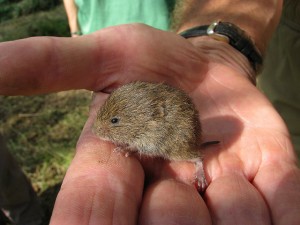When might it be better to tolerate a macroparasite than to resist it?

Credit: Flickr/wolf359 Creative Commons CC BY-NC-SA 2.0
Out in the wild, it’s difficult to avoid parasites. Ticks perch in the grass, poised to latch onto unsuspecting passersby, food may be laced with the eggs of intestinal worms, and fleas abound. Once the inevitable infection occurs, the unlucky host’s immune system has two courses of action: resistance (dispelling the parasite) or tolerance (minimizing the damage). Which of these paths is set into motion is an interplay of the surroundings, the parasite, and the life history of the host. In nature, circumstances may lead to either response and, in some cases, tolerance can be the preferred strategy.
There are few studies of tolerance to macroparasites, and even fewer in the wild. When it comes to the immune system, laboratory experiments – with their young, tidily-kept, and well-fed mice – often give a skewed picture. To complete the story, it’s necessary to get out into the field as well. To create a holistic picture of tolerance and resistance in wild mammals, Dr. Jackson and his colleagues collected the life histories and accompanying immune biomarkers of wild field voles. They sought to understand resistance and tolerance from a molecular level up through to long-term fitness and survival.
Radio-tagged voles received monthly check-ups to follow their size, weight, fertility, parasite load, and blood levels of immune molecules. Tolerance meant being in relatively good health despite a high, and often increasing, number of parasites. In contrast, resistance manifested as a reduction in the number of parasites over time, showing that the vole was fighting off the infection. In addition to the fieldwork, some voles were brought back to the lab for more rigorous profiling of immune-related genes.
“A key point is that we’ve got two different sampling modes,” explains Dr. Jackson, at Aberystwyth University in Wales. “There’s cross-sectional data, which are basically snapshots, pictures really, of individual animals at a moment in time… The other type of data is longitudinal where we marked individual animals with a transponder to monitor those animals through time and re-record immune gene expression measurements and parasite levels.”
While the potential for pregnancy convoluted results for female voles, the majority of the mature males showed tolerance, while immature males tended towards resistance. Surprisingly, the tolerant mature males were often relatively plump and healthy, albeit somewhat less virile. Mature voles with the most parasites were actually the fittest of all.
On a molecular level, one immune marker stood out: Gata3, a transcription factor that mediates T-helper cell type 2 (Th2) production. The Th2 pathway is already associated with resistance, but the connection to tolerance is less established. Gata3 expression also correlated to survival in an unexpected way, as Dr. Jackson explains. “In younger male animals expressing a lot of Gata3, Gata3 correlates with an increased probability of dying, but as the animals age, the ones that express more Gata3 relative to other older animals start to survive better and then by the end of things, are surviving better than animals who are not expressing much Gata3, for their age.”
Dr. Jackson speculates that the shift to tolerance in older males may be a re-allocation of resources from reproduction, potentially the focus of developing males, to survival. “In adult males, there’s an increase in the cost of resistance to the point where it becomes unsustainable. Immune responses… that produce resistance are costly. They’re energetically costly and immunity, inflammation in particular, is very, very damaging to the host itself. So there’s a cost in terms of collateral self-damage.”
The researchers plan to explore the effects of food availability and infection levels next, aiming “to reverse engineer the different networks within the immune system and links to other life history traits.” While natural settings sometimes make for deviously complex experiments, it is often the best route to a comprehensive picture. “It will, we hope, show how the immune system works in a natural setting,” says Dr. Jackson. ~K.E.D.C.

